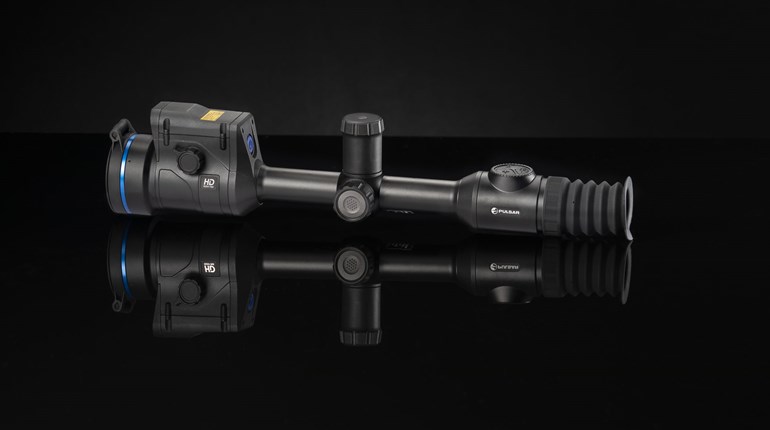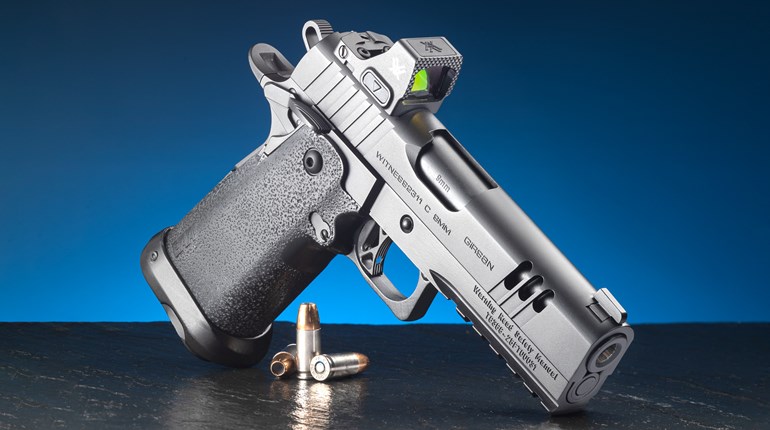
You’re at another sporting goods store—your third of the day—and all you want is some 9mm practice ammo for your Glock. But the pandemic scene is like a nightmare; empty shelves and angry customers just like you everywhere! But then, there, on the endcap aisle display, you dig way behind the near-bare .40-caliber shelf to uncover two—I say two!—50-round boxes of Wolf 115-gr. 9mm Luger FMJ Steel-Case ammo! Like a starving hound you snatch them up and make haste to the register. You’re the type who’s normally not this lucky … so there’s gotta be a catch, right? While in line you search the internet for info about steel-case ammo. And here’s where it gets more confusing than the U.S. tax code:
Some folks believe steel-case ammo will readily cause undue wear on your firearm and break it. Others bemoan extraction issues and say you should never use it. Still others say it’s fine, and even great for the money. So what’s the deal with steel-case ammo?
Let’s state the facts.
- Steel-case ammo was first made in Russia and Germany during World War II to save production costs, because steel is cheaper than brass.
- With everything else being equal, steel-case ammo is less expensive than brass-case ammo today, often 30- to 40- percent less.
- Imported Russian/Eastern bloc steel-case ammo tends to also be made with lesser quality/cheaper components, including powders, primers and bullets. Cheaper powders, primers and metals tend to foul barrels, chambers and actions faster and move heavily.
- Steel is harder than brass, but the steel used in modern gun parts is harder than the steel used in cheap ammo.
- Steel cases are coated with lacquer or polymer to reduce corrosion.
- Steel is a ferrous metal that is attracted to a magnet.
- Berdan-primed ammo is non-reloadable—often dirtier and cheaper than Boxer-primed ammo.
- Steel and brass contract and expand at different rates; modern semi-autos are designed and tested with brass cartridges.
- Straight-walled caliber cases have more issues extracting when fouled than tapered case calibers.
- Cheap, steel-case ammo tends to be less reliable than expensive, brass-cased ammo in semi-auto firearms. In revolvers and non-semiautomatic guns, it often functions fine.
So what do these facts tell us about firing cheap steel-case ammunition in your modern handgun?
There are three potential issues that could make steel-case ammo less reliable than more expensive types. First, cheap steel-case ammo—especially that made in Eastern Europe—tends to utilize cheap powders, dirty Berdan primers and anti-corrosion coatings applied for shipping and long-term storage. All of these components can potentially foul guns at a quicker rate, and to a grimier degree, than top-quality ammo. Most reliability issues associated with steel-case ammunition can be attributed to this fact and not due to the steel case itself.
That’s because once a gun becomes heavily fouled, space between the case and chamber wall is reduced. This creates more friction and more pressure that forces the case even harder into an already tighter space. Naturally, this makes extraction more difficult—especially in straight walled cases like .45 ACP—often increasing the rate of failures to extract the steel case.
While some folks believe extractors of semi-auto guns are more frequently broken due to the steel extractor pounding against the rim of the steel case repeatedly, there is copious data to suggest steel cases alone very rarely damage the extractors of modern, quality-made guns.
“Our extensive testing never exposed this problem,” said Hornady’s Neil Davies, whose company offered steel-case ammunition for a time. “We fired thousands upon thousands of rounds through guns in our testing. Extractors have a lifespan, and nothing we tested saw extractors fail before their expected maintenance window.”
What may play more of a role in reliability issues is the fact that brass and steel expand and contract at different rates. Modern semi-automatic guns are designed and tested with brass ammunition, so any difference in timing during the firing/ejecting/reloading cycle can increase the chance of malfunction.
Regardless of why, if steel-case ammunition is less reliable in semi-autos, should you use it?
First, if steel-case ammo is all you can find, of course you should use it—for practice. It’s a great choice for people who don’t reload. And it’s much faster to pick up and throw away because you can use a roofing magnet to capture it. Just know that you may experience more malfunctions and therefore an increase in cleaning time.
What can you do to keep your gun running on a diet of steel?
If you opt for cheap ammo, you should clean your guns more often. While it’s impossible to predict to what degree each batch of ammo will foul a specific gun, a good rule of thumb is to clean your firearm at the first sign of heavy fouling.
Signs of heavy fouling include: The gun’s slide is tough to open and to close; the gun may not go fully into battery without a manual push; groups start opening up; the chamber, sidewalls, slide, feed ramp and extractor are visually very dirty; the gun experiences a malfunction.
When starting with a clean gun, note how many shots are taken before the gun begins jamming with a particular type of ammo. Then, during future range sessions, clean the gun before that number is reached. For some the cheapest types of ammunition, it can be as often as every 50 to 100 rounds.
That means you'll want to bring your cleaning supplies to the range, because you may not be finished practicing before your firearm needs cleaning. Cleaning supplies should include: Carbon solvent, brass brush, dry patches and a cleaning rod/jag, a scraping tool (any small metal tool—think dentist’s tool—that can remove grime from small parts such as the extractor), and lubricating oil. Remember that cleaning fouling from your gun is different from lubricating it. Guns should be cleaned first with a carbon solvent, then oiled before firing.
Quite simply, if you plan to use inexpensive steel case ammo, also plan to clean your semi-automatic gun more frequently. If your gun tends to reject one brand, try another brand before giving up on steel-cased ammo altogether. A little extra care and attention can keep your gun running on a diet of steel.







































